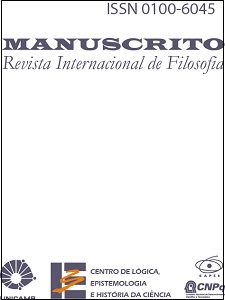Resumo
In this paper Chateaubriand’s approach to solve some problems related to the nature of logic is confronted with the traditional approaches. It is shown that his hierarchy of logical types opens up new possibilities to characterize logical properties and logical truths and that it also sheds some new light on the foundations of mathematics.Referências
BELLOTTI, L. “Tarski on logical notions”. Synthese, 135, pp. 401-413, 2003.
CHATEAUBRIAND, O. Logical Forms. Part I. Truth and Description. Campinas: Centro de Lógica, Epistemologia e História da Ciência/ UNICAMP, 2001. (Coleção CLE, 34)
KANT, I. Kritik der reinen Vernunft (KrV). Second Edition. Riga: Johann
Friedrich Hartknoch, 1787. Transl. By N. Kemp Smith, London: Macmillan, 1929.
MACFARLANE, J. G. What does it mean to say that logic is formal? Doctoral thesis. University of Pittsburgh, 2000.
SAUTTER, F. T. “O papel das classes próprias na fundamentação das ciências formais.” O que nos faz pensar?, 17, pp. 99-105, 2003.
TARSKI, A. “What are logical notions?”. History and Philosophy of Logic, 7, pp. 143-154, 1986.
VAN FRAASSEN, B. “Logical structure in Plato’s Sophist.” The Review of Metaphysics, 22, pp. 482-498, 1969.
WANG, H. A Logical Journey: From Gödel to Philosophy. Cambridge/ London: The MIT Press, 1996.

